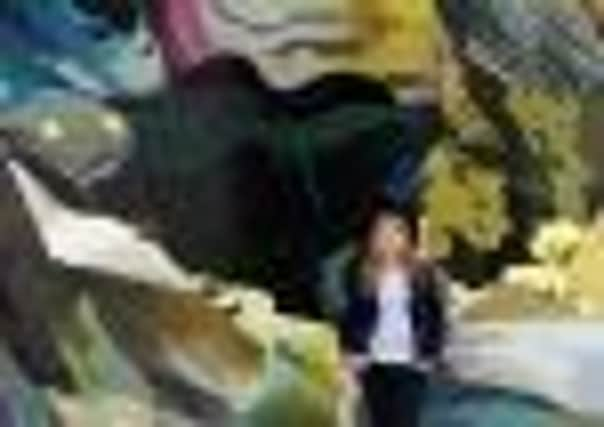A larger landscape ...and an epic sense of place


SOMETIMES it takes the objective, appraising eye of an outsider to see and communicate a fresh perspective on a place we may take for granted and think we know quite intimately. Take two of Yorkshire’s most striking geological features – Brimham Rocks near Ripon and the Cow and Calf Rocks at Ilkley.
Popular haunts for days out and playgrounds for adults and children alike, both rise like alien life forms out of their landscape. But familiarity can take the edge off wonderment. Yet I suspect that both will be viewed with renewed curiosity by anyone who travels to Hepworth Wakefield to see Clare Woods’s new exhibition The Unquiet Head.
Advertisement
Hide AdAdvertisement
Hide AdA major focus of the 13 commissioned works on show here are large-scale paintings customised to the luxuriously sized galleries.
These complex, multi-layered images rendered in oil and enamel on panels of aluminium show that painting is very much of the now, not some sort of nostalgic indulgence. Given a free rein with her show, but bearing in mind the relationship and tension between urban and rural environments, Woods set off with her camera to capture places and moods around Yorkshire to feed into her works, which are made in a large studio at her home in Herefordshire.
Measuring up to 10.5m long and 6 metres high, the pieces also respond both to the architectural scale of the four galleries in which they are shown and to the work of 20th century British artists with an interested in the landscape and natural forms. Just as Nash, Piper and Sutherland explored the mystery of geological formations, Woods has found, particularly in the quasi-lunar landscape of Brimham, a world that evokes contrasting emotions and is ripe with suggestion.
Visually ambiguous, sometimes disturbing and definitely claustrophobic, it is as though Woods is telling us through her representation of rocks and tangled vegetation about her own conflicted relationship with the rural environment. Having studied and lived in London for many years, she moved to the country relatively recently, and finds she has experienced feelings of alienation from and ambivalence about both city and countryside, but in different ways.
Advertisement
Hide AdAdvertisement
Hide AdSome of the images are full of foreboding, the encroachment of nature on a human being entering the corridors of ancient rock which threaten to engulf and even devour. Others are imbued with playful pinks and aquas, suggestive not just of seething ecology but of complete worlds encased secretly by the granite. The Bloody Kernel, in particular, evokes memories of Brimham Rocks as a children’s paradise while also showing that enjoyment of the carapace is only half the story.
The artist’s mastery of her tools and technique make these paintings emotionally and aesthetically deeply satisfying. The layering of paint on webs of enamel atop the slight luminosity lent by aluminium is strangely both ethereal and solid. The work is also wonderfully sculptural.
“I took hundreds of photographs during my research,” says Woods, who is 39. “I wanted some of the pieces to have a collaged feel and create a world within the landscape. I also wanted the pieces to work with the landscape of the gallery, and I have just for the first time seen the largest one, Tragic Head, in its entirety. I work on the pieces flat on the floor, and it wasn’t possible to see how this one had really turned out until it was in situ. I’m pleasantly surprised.
“I’ve been working on landscapes for years, I’m interested particularly in the psychological aspect – what feelings you experience as you travel through certain places. I knew something of the Yorkshire landscape through the works of Hockney, Moore and Hepworth and studied the history of these amazing places that inspired me. I found that in Georgian times some of the rocks at Brimham had been carved to make them more appealing, and felt very aware of how many centuries of visitors had, like me, seen faces in the formations. The rich layering of the rock and vegetation very strongly convey moods that change with variations of light, affecting the sense of place.” The process of creating these works involved selecting and translating shapes from photographs onto acetates then projecting these onto aluminium sheeting before cutting the outlines into the metal through masking tape and eventually applying enamel and paint, wet on wet.
Advertisement
Hide AdAdvertisement
Hide AdWoods has a strong sense of both working within a pastoral tradition in British art, but of also trying to extend boundaries in how responses to landscape are expressed.
“Being able to work at this sort of scale, because of the gallery space available has meant I’ve really pushed these pieces to a place I could not otherwise have done.”
The Unquiet Head is at The Hepworth Wakefield from tomorrow until Jan 29, 2012. www.hepworthwakefield.org
Portrait of the artist
Clare Woods was born in 1972 in Hampshire and graduated from Bath College of Art before taking a masters at Goldsmiths College in 1999.
Advertisement
Hide AdAdvertisement
Hide AdShe has exhibited in the UK, Europe and America. Recent shows include The Dark Monarch: Magic and Modernity in British Art, Tate St. Ives, Cornwall; Monuments with a horizon line II, Buchmann Galerie, Berlin; Watercolours, Buchmann Box, Berlin; Cemetery Bends, Pilar Parra & Romero, Madrid.
For many years she was based in London but lives and works in Herefordshire with her sculptor husband and their two young children.